Your Guide to Clothes Organizers for Small Closets

We’ve all been there—staring into a closet so packed you can't see what you own, let alone pull something out. That daily frustration is exactly why finding the right clothes organizers for small spaces isn't just a nice-to-have; it's a game-changer for your closet. This is about more than just making things look tidy. It's about reclaiming your closet space, saving precious time on busy mornings, and bringing a little more calm to your daily routine.
From Closet Chaos to Calm Control
Turning that cramped closet into a streamlined, functional space all starts with a shift in thinking. So many people automatically assume they need a bigger closet, but I've found that what they really need is a smarter system. With the right approach, you can practically double your closet's storage capacity without a single sledgehammer. It’s about creating a lasting framework for order, not just a temporary fix.
This isn’t just a niche obsession, either. The demand for smart storage is booming globally as more of us move into smaller homes and embrace more intentional living. In fact, the global closet organizer market was valued at an impressive USD 12.5 billion in 2023 and is expected to climb to USD 19.8 billion by 2032. This surge is all about people wanting to make every single square foot of their closet count. You can read the full research about home organization market trends to see just how big this shift is.
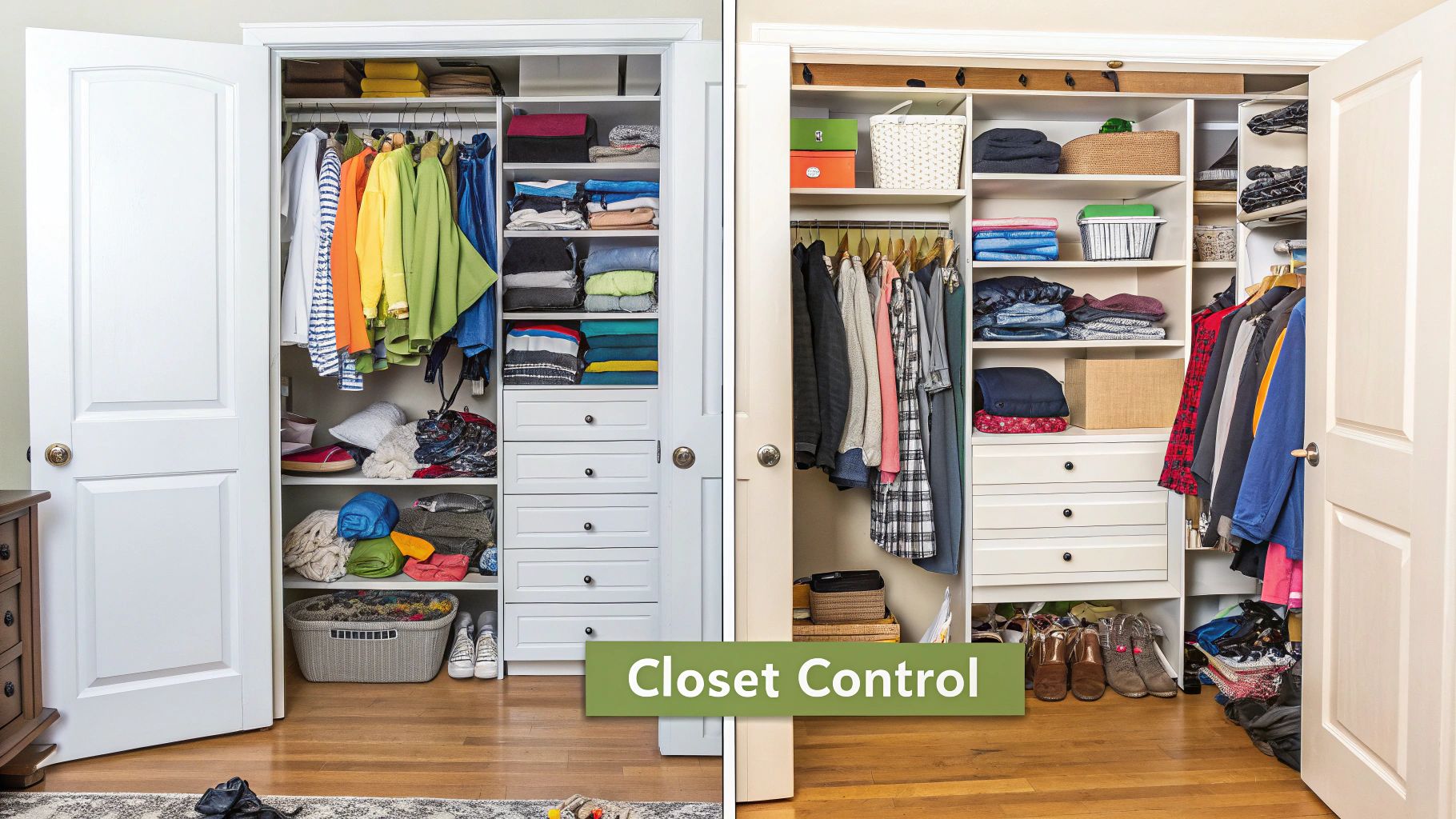
Core Principles for Small Closet Success
Before diving into specific products and hangers, it's crucial to get the basics right. These foundational ideas are what separate a closet that looks organized from one that actually works for you day in and day out.
| Principle | Why It Matters for Small Closets | Quick Action to Take |
|---|---|---|
| Go Vertical | When floor space is limited, the only way to go is up. Using vertical space draws the eye upward and multiplies your storage potential without a larger footprint. | Add a hanging shelf organizer or a stackable bin to an unused corner of your closet. |
| Visibility is Key | If you can't see it, you won't wear it. Hidden items get forgotten, leading to a wardrobe of "nothing to wear" and unnecessary duplicate purchases. | Use clear storage boxes for seasonal items or open-front bins so you can see the contents at a glance. |
| Group Like with Like | Categorizing your clothes (e.g., all T-shirts together, all work pants together) makes finding specific items intuitive and fast. No more frantic searching. | Spend 15 minutes regrouping just one section of your closet—like your shirts—by type and then by color. |
| Maximize Every Nook | The back of the door, the floor space under short-hanging clothes, and the high top shelf are often wasted real estate. These are prime spots for extra storage. | Install an over-the-door shoe rack or place a low-profile basket on the floor for accessories. |
Getting these principles down first makes choosing the right organizers so much easier and more effective.
Why Bother Organizing a Small Closet?
A well-organized closet delivers benefits that ripple through your entire day. It's about introducing a sense of order that eliminates the low-grade stress of digging through piles to find that one specific shirt. When you have a compact closet, every inch matters, and efficient storage becomes a true necessity.
Here are the real-world perks of getting your closet in order:
- You save time. Seriously. An organized system means you can grab what you need in seconds, making your morning routine so much smoother.
- You feel less stressed. Visual clutter is mental clutter. Clearing it out has a tangible calming effect, turning your closet into a more peaceful space.
- You actually see your wardrobe. When you can see everything you own, you’ll discover old favorites and stop buying duplicates of things you already have.
- Your clothes last longer. Storing items properly prevents wrinkles, stretching, and snags, extending the life of the clothes you love.
The goal isn't just to cram more stuff into a tiny closet. It's to build a functional, intuitive system that makes your life easier and brings a sense of effortless order to your home.
Ultimately, taking control of your closet is often the first domino to fall in creating a more organized life. It's an empowering feeling to master the space you start and end your day in.
Creating Your Closet Blueprint
It's so tempting to see a cool-looking organizer online and click "buy," but trust me, that's a recipe for frustration. Jumping in without a plan is one of the biggest mistakes I see people make. Think of it like this: you wouldn't start a road trip without a map. A few minutes spent sketching out a blueprint for your closet will save you a ton of time, money, and hassle down the road.
First things first, you need to know exactly what you're working with. Don't just guess or "eyeball" the space. Grab a tape measure and get the hard numbers.
- Width: Go wall to wall.
- Height: Measure from the floor all the way up to the ceiling.
- Depth: Check the distance from the back wall to the inside of the door frame.
Jot these down. While you're at it, measure any existing shelves or rods, noting their placement. These dimensions are the absolute boundaries of your project—they’ll tell you right away what can and can't work in your closet.
Taking a Closet Inventory
With your measurements on a notepad, the next step is to figure out what you actually need to store. This is more than just a quick headcount of your clothes. You need to group your items by how they should be stored. A proper inventory is the secret to picking organizers that solve your clutter problems instead of just creating new ones. It helps you see clearly whether you're desperate for more hanging space or if shelves for bulky sweaters are the real priority.
A detailed inventory stops you from buying organizers for the closet you wish you had. Instead, it helps you equip the closet you actually have. Honestly, it’s the most critical step toward a truly functional space.
This little decision tree gives you a great starting point for categorizing everything and seeing what your wardrobe really needs.
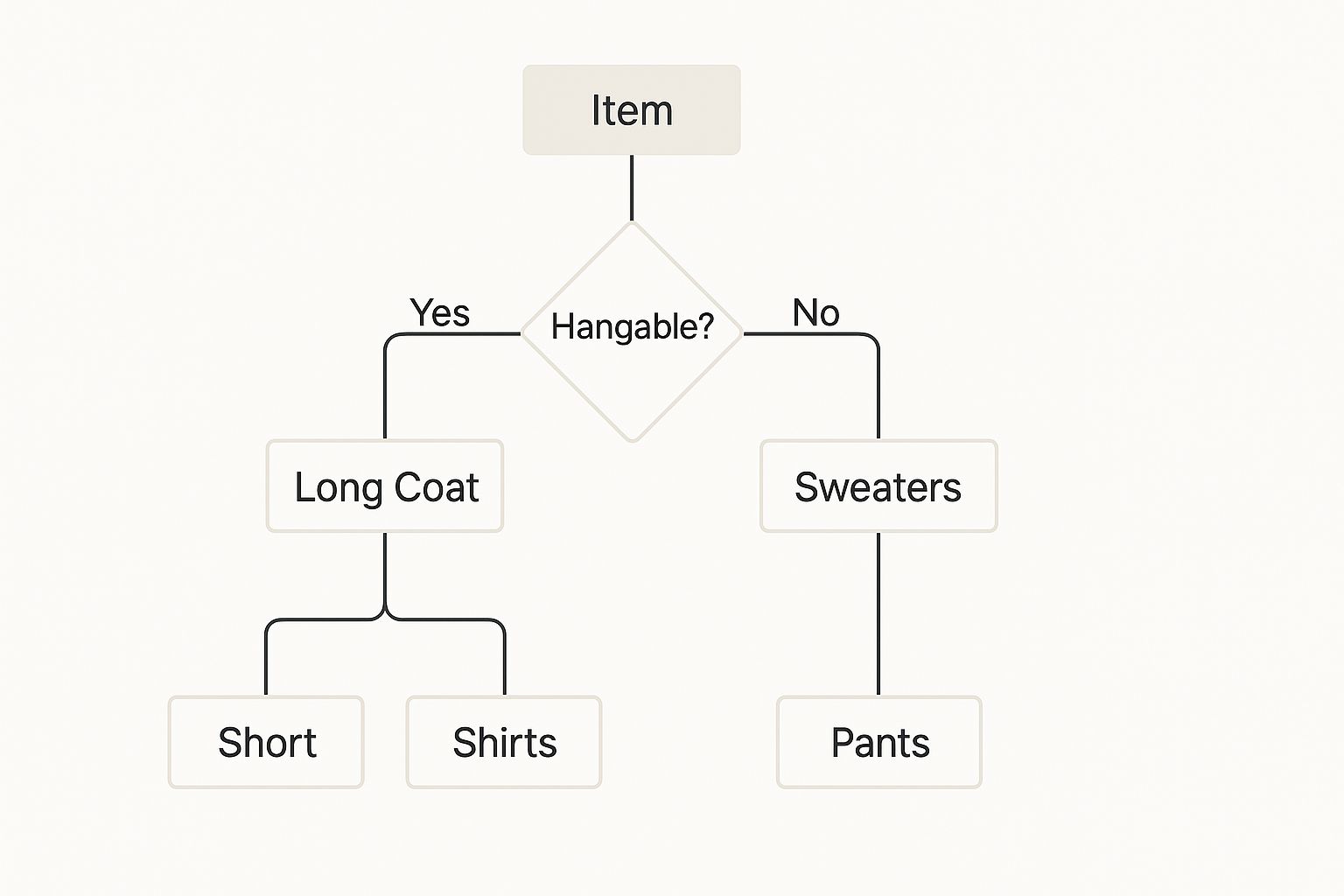
As you can see, once you start separating items into groups like "long hang," "short hang," and "foldable," a clear picture emerges. You might have a lightbulb moment and realize only 20% of your clothes are actually long items. That means all that empty space under your shirts is prime real estate for a second hanging rod or a set of drawers.
Building Your Action Plan
Okay, this is where the magic happens. Let's merge your closet measurements with your inventory list. Your blueprint is about to come to life.
For instance, if your inventory showed you have 40 shirts but only 5 long coats, you know a double-rod system is a smart move. If you counted 15 bulky sweaters, you can confidently prioritize something like hanging fabric shelves or a few stackable bins.
Your finished blueprint might look something like this:
- Top Shelf (High Storage): For out-of-season stuff (need 6 bins).
- Hanging Rod (Primary): All my short-hang items (shirts, jackets).
- Below Rod (New Storage): Add a small 3-drawer unit for folded jeans and shorts.
- Floor Space: A low-profile shoe rack for my 8 most-worn pairs.
- Back of Door: Snag an over-the-door organizer for scarves and belts.
Suddenly, you've gone from a vague goal to a concrete shopping list. If you want to dive even deeper into layout strategies, check out this guide on how to design a closet for more pro tips. With your blueprint in hand, you're ready to find the perfect tools for the job.
Alright, you've measured your space and have a clear vision. Now for the fun part: picking the right gear to make it all happen. Think of this as your personal buyer's guide, but one that’s grounded in solving real-world closet problems. The goal isn't just to accumulate cool gadgets; it's about matching the perfect organizer to your specific headache so you're investing in solutions that actually work.
And there are more options than ever. The home organization market is booming, expected to hit $13.27 billion in 2025, largely because so many of us are dealing with smaller living spaces and a desire for a more minimalist lifestyle. As Woodworking Network points out, this growth means we have access to smarter, more effective organizers designed specifically for tight quarters.
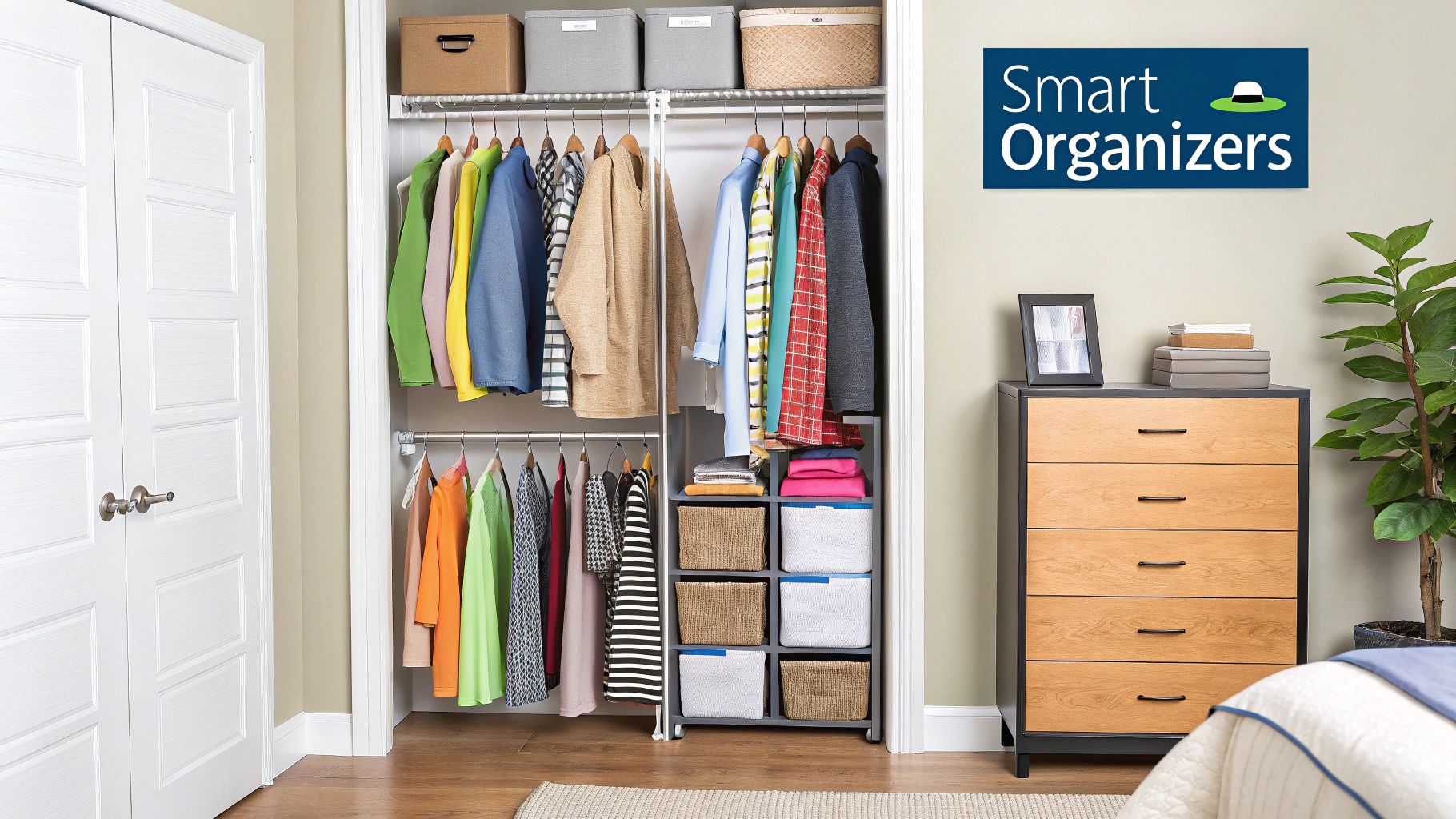
Hangers That Magically Create Space
Let's start with the single most effective change you can make: swapping out your hangers. If you're still using those bulky plastic or mismatched wire hangers, you're giving up precious real estate in your closet. They are absolute rod-space hogs.
Slim velvet hangers are, in my opinion, non-negotiable for a small closet. Their super-thin profile can genuinely give you back up to 50% of your hanging space. It sounds like an exaggeration, but it's true. Plus, the velvety grip stops slinky tops and wide-neck sweaters from constantly ending up in a pile on the floor.
Beyond the basics, think about hangers designed for specific problems:
- Tiered Pant Hangers: A lifesaver for anyone with a collection of jeans or work trousers. Products like MORALVE's multi-pant hangers let you hang several pairs in the vertical space of a single hanger. It's a total game-changer.
- Cascading Hooks: These little things are pure genius. They let you hook hangers onto each other, creating a vertical chain of clothing. I love using them to group entire outfits together.
- Specialized Hangers: Got a ton of tank tops or skirts? Hangers with multiple clips or hooks consolidate these items beautifully, freeing up a surprising amount of rod and drawer space.
By simply upgrading your hangers, you're not just tidying up; you're actively creating more usable square footage on your closet rod. It's the highest-impact, lowest-effort upgrade you can possibly make.
Of course, once you have a collection of great hangers, you need to keep them from becoming a tangled mess themselves. We've put together some simple tips, and you can check out our guide on how to store hangers to keep them neat when not in use.
Matching Organizers to Your Closet Challenges
Feeling a bit overwhelmed by the options? That's normal. This little table breaks down common closet frustrations and points you to the best tool for the job. It's a quick way to diagnose your problem and find the right solution.
| Your Closet Problem | Top Organizer Solution | Perfect For Storing | Pro Tip |
|---|---|---|---|
| Crammed closet rod | Slim Velvet Hangers | Blouses, dresses, button-downs, slacks | Switch out all your hangers at once for a uniform look and maximum space gain. |
| No shelf space | Hanging Fabric Shelves | Bulky sweaters, sweatshirts, jeans | Place heavier items on the bottom shelves to maintain balance and prevent sagging. |
| Cluttered closet floor | Fabric or Clear Bins | Scarves, belts, seasonal items, workout gear | Use clear bins for things you need to identify quickly, like off-season clothing. |
| Messy stacks of pants | Multi-Pant Hangers | Trousers, jeans, leggings, scarves | Look for hangers with swing-out arms to make grabbing a specific pair easy. |
| Wasted vertical space | Over-the-Door Organizer | Shoes, rolled t-shirts, accessories, toiletries | Choose one with clear pockets so you can see everything at a glance. |
Think of this as your cheat sheet. When you know exactly what problem you're trying to solve, picking the right organizer becomes a whole lot easier.
Shelving and Bins for Everything Foldable
Not everything should be on a hanger. Sweaters, t-shirts, and workout gear are usually better off folded to prevent stretching. The obvious problem in a small closet is the severe lack of shelf space.
This is where hanging fabric shelves really shine, especially for renters. These organizers hook right onto your closet rod, instantly creating a stack of cubbies without a single drill hole. They're perfect for those bulky hoodies and sweatshirts that would otherwise eat up an entire drawer.
For the high shelves or the closet floor, bins are your best friend.
- Clear Bins: These are my go-to for off-season items like swimsuits or winter hats. You can see exactly what's inside without having to pull down three different boxes.
- Fabric Bins: Great for corralling smaller accessories like socks, belts, and scarves. They also add a soft, polished look to your shelves.
- Stackable Modular Units: For those really awkward corners or layouts, these are brilliant. You can buy individual cubes or drawers and configure them to fit your exact space, basically creating a custom dresser right inside your closet.
Don't Forget the Hidden Spaces
Finally, it’s time to get creative and look for the untapped potential in your closet's hidden spots. Every small closet has them—you just have to know where to look.
Over-the-door organizers are classics for a reason. They put the entire vertical surface of your door to work, an area that is otherwise completely wasted. While many people use them for shoes, they're also fantastic for rolled-up t-shirts, cleaning supplies, or accessories.
Similarly, look into under-shelf baskets. These clever additions hook onto the bottom of an existing shelf, creating a whole new layer of storage for small, flat items like clutches or wallets. By using smart organizers like these, you can ensure that every single inch of your closet is pulling its weight.
Mastering Vertical Space and Installation
Alright, you've got your plan and your organizers are ready to go. Now for the fun part: bringing it all to life. This is where we get hands-on and, most importantly, start claiming all that underused vertical space. In a small closet, thinking upwards is the single best trick for multiplying your storage without knocking down a wall.
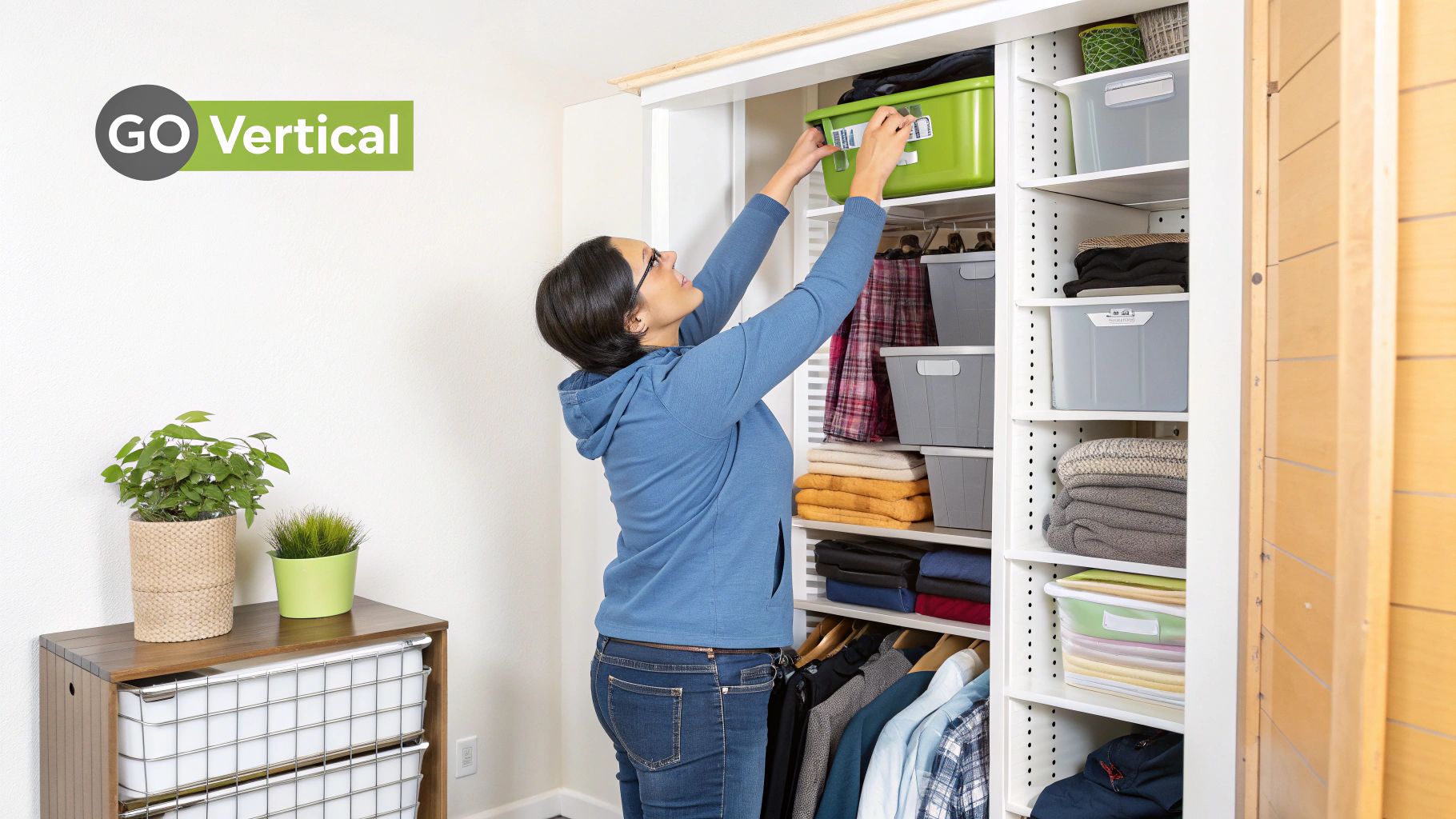
Think about the typical closet: one high shelf and a single rod. That design leaves a massive amount of dead air just hanging around. Our goal is to fill that empty space with smart, functional layers, effectively building a multi-level system that can dramatically expand what your closet can hold.
Building Your Vertical Storage System
My rule of thumb is to start at the top and work your way down. Get your highest shelves installed first. This is prime real estate for things you don't need every day—think off-season sweaters in clear bins, that extra set of bedding, or your suitcase. Putting them up high keeps them accessible but completely out of the way of your daily routine.
Next, look at your hanging space. Does your closet have enough height for a second rod? Most do. You can easily hang shirts and blouses on the top rod and folded pants or skirts on a lower one. This simple move instantly doubles your hanging capacity. An adjustable rod that hooks onto the existing one is a great no-drill option.
The most effective small closets are organized like a cityscape, with different "levels" serving different purposes. High shelves for long-term storage, eye-level rods for daily wear, and floor-level drawers for folded items create an intuitive and efficient flow.
Securing Your Organizers Like a Pro
Nothing is more frustrating (or potentially dangerous) than a wobbly shelf or a swinging over-the-door rack. Proper installation isn't just about looks; it's about stability and peace of mind. For anything that mounts to the wall, like shelves or a fixed rod, finding the wall studs is non-negotiable.
- Finding Studs: A stud finder is your best friend here. If you don't have one, you can do the old-school knock test. A hollow sound is just drywall, but a solid, dull thud tells you there's a stud behind it. As a general rule, studs are spaced 16 inches apart.
- Choosing Hardware: I rarely trust the tiny screws that come in the box. For anything bearing real weight, you need to drive long wood screws directly into a stud. If you can't hit a stud, use quality drywall anchors for lighter items.
Here’s a little trick for over-the-door organizers: to stop them from banging against the door every time you open it, stick a couple of Command strips or adhesive hooks to the bottom corners. This keeps the whole unit flush and secure. If you're looking for more clever tricks, exploring different space-saving clothing storage methods can give you some fresh ideas.
The Right Tools for a Smooth Installation
You don't need a full workshop for this project. Just having a few essential tools on hand will make the installation process a thousand times easier and ensure everything is sturdy and straight.
- Tape Measure: Essential for double-checking your measurements and making sure everything is centered.
- Level: Don't skip this! A level is the only way to guarantee your shelves and rods aren't crooked. A leaning shelf is a weak shelf.
- Power Drill: This will save your wrists and make driving screws into studs or installing anchors a quick and secure process.
- Pencil: For marking exactly where you need to drill. Remember the carpenter's motto: measure twice, drill once!
By focusing on these vertical layers and taking a little extra time to install everything securely, you’re not just organizing—you’re transforming a simple box into a powerful, high-capacity storage machine.
Keeping Your Newly Organized Closet in Check
That feeling of a perfectly organized closet? It’s fantastic. But the real win is making it last. The secret isn't some huge, soul-crushing clean-out every few months. It's all about building tiny, almost effortless habits that stop the clutter from ever taking hold again.
This is how you turn that one-time project into a permanent, stress-free part of your home. These little routines only take a few minutes, so you can actually stick with them and protect the order you worked so hard to create.
The goal isn't a flawless, magazine-worthy closet every single day. It's about consistency. A few small habits, done regularly, are way more powerful than one massive cleaning binge every six months. This keeps your closet working for you, even as your wardrobe evolves.
It's All About Simple Habits
To keep your closet tidy, a few key practices can make all the difference. One of the best is the classic 'one-in, one-out' rule. Anytime you bring a new shirt or pair of jeans home, an old one has to leave. This simple trade-off stops your closet from overflowing and makes you think critically about what you really love to wear.
Another game-changer is the 15-minute weekly reset. Seriously, just set a timer for 15 minutes once a week. Use that time to put away any stray clothes, straighten up your shoes, and refold anything that's gotten messy. You’ll be shocked at how much you can get done, and it prevents those small messes from snowballing.
- The Daily Two-Minute Tidy: Before you go to bed, take just two minutes to put away the clothes you wore that day. Hang them up or toss them in the hamper.
- Fold with Purpose: Pick a folding method, like the file-fold technique, and stick with it. When items stand up in drawers, you can see everything at once. No more digging!
- Decide on the Spot: When you take an item of clothing off, make an immediate call. Does it go in the laundry, back on the hanger, or into a donation bag? Don't let it sit in limbo.
Don't Forget the Seasonal Reset
Twice a year, usually when the weather starts to turn, block off about an hour for a seasonal swap-out. This is your chance to move bulky, out-of-season clothes (like your winter parkas in July) into less accessible storage spots. Think higher shelves or under-bed bins. This frees up the prime, easy-to-reach real estate for the stuff you're actually wearing now.
This is also the perfect time for a quick decluttering session. As you're packing away your winter sweaters, you'll immediately notice the ones you didn't touch all season. Those are perfect candidates for your donation pile.
This kind of regular maintenance ensures your clothes organizers for small spaces are always working efficiently. With the home organization market booming, there are always new solutions popping up. In fact, experts are predicting the global closet organizers market will grow at a CAGR of 7.8% between 2025 and 2035, thanks to a huge push in home improvement trends. You can discover more insights about closet organizer market growth and see why so many homeowners are making this a priority.
Common Questions About Small Closet Organization
Even the best-laid plans run into a few snags. When you're wrestling with a small closet, a few questions always seem to pop up right in the middle of the project. Let's tackle some of the most common ones I hear, so you can keep the momentum going.
How Can I Make My Small Closet Feel Bigger?
This is the million-dollar question, isn't it? Making a tiny closet feel more spacious is part smart organization, part visual magic. Your first move is a ruthless decluttering session. If you don't love it or wear it regularly, it doesn't get to stay. This single step is the most impactful thing you'll do.
Next, get all your clothes on a uniform set of slim hangers. It's a small change that makes a huge difference, creating a clean, cohesive look and instantly freeing up precious rod space. Don't forget about lighting! A simple battery-powered LED light strip inside the door frame can banish dark corners, making the whole space feel brighter and more open.
The real secret weapon is using your vertical space. Think up, not out. A hanging shelf organizer or even a second closet rod for shorter items like shirts and skirts can literally double your storage without taking up any new floor space.
What Is the Best Way to Store Shoes in a Small Closet?
Shoes are the number one cause of closet floor chaos. The goal is simple: get them off the ground. For this, an over-the-door shoe organizer is an absolute classic for a reason. It uses that totally wasted space behind your door and doesn't eat into your closet one bit.
If you have a little bit of floor to spare, a tiered or stackable shoe rack works wonders. For those special-occasion heels or off-season boots, I always recommend clear, stackable shoe boxes. They keep everything dust-free and let you see exactly what’s inside, so you’re not tearing through boxes to find the right pair.
Are Fabric Hanging Organizers a Good Choice?
Absolutely, especially if your closet is just a rod and a shelf with no built-in drawers. Fabric hanging organizers are fantastic for creating instant cubbies. They're perfect for neatly storing folded sweaters, jeans, and t-shirts that would otherwise end up in a messy pile.
The biggest wins? They're incredibly lightweight, require zero installation—you just hang them on the rod—and are a dream for renters. That said, if you're storing very heavy items or want to protect things from dust long-term, you might be better off with sturdier wire drawers or lidded bins. Think of fabric organizers as your go-to for flexible, everyday folded clothes storage.
Ready to finally win the war against closet clutter? Having the right tools is half the battle. Check out the collection of space-saving hangers and organizers from MORALVE to start building a closet that actually works for you.
You can begin your transformation right here: https://moralve.com.
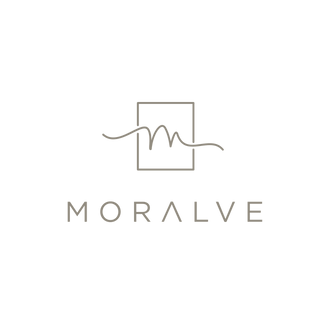

Leave a comment